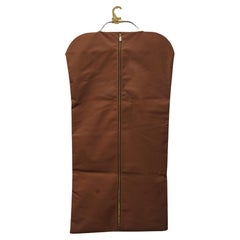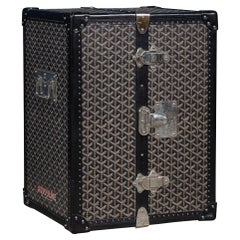French Home Accents
to
92
539
364
927
34
16
261
90
30
27
18
17
13
9
7
5
4
3
3
2
1
1
1
45
183
699
50
232
254
66
17
13
81
86
35
24
27
30
13
3
570
411
260
256
252
2,962
1,008
977
907
712
977
962
966
174
21
13
8
5
Place of Origin: French
Louis Vuitton of Paris Tan Canvas Dress Suit Carrier With Brass Hanger
By Louis Vuitton
Located in Reading, Berkshire
Louis Vuitton of Paris Dress Tan Canvas Suit Carrier With Monogrammed Brass Handle With Monogrammed Brass Handle
Full height with handle in use 113cm
Width 51cm
Depth 2cm
Height w...
Category
21st Century and Contemporary Modern French Home Accents
Materials
Brass
Art Deco Bookends attributed to Jacques Adnet circa 1930
By Jacques Adnet
Located in BARCELONA, ES
Owning these Art Deco bookends attributed to Jacques Adnet circa 1930 is like possessing a slice of design history infused with timeless elegance. Jacques Adnet, a luminary of the Ar...
Category
1930s Art Deco Vintage French Home Accents
Materials
Chrome
1920's Louis Vuitton Trunk in Monogram, 100 cm Louis Vuitton Steamer Trunk
By Louis Vuitton
Located in Saint-Ouen, FR
This superb Louis Vuitton steamer trunk features stenciled monogram canvas, deep chocolate color leather trim, LV stamped solid brass locks and studs as well as solid brass side hand...
Category
1920s Vintage French Home Accents
Materials
Brass
Four-Panel Bamboo Wicker Rattan Folding Screen Room Divider, France 1960s
Located in Miami, FL
This Mid-Century-Modern eye-catching rattan or wicker and bamboo four-panel room divider with filigree decoration was crafted in France in the 1960s. This rattan screen combines mid-...
Category
Mid-20th Century Mid-Century Modern French Home Accents
Materials
Rattan
French Art Deco 3-Fold Gilt Screen with Upholstered Panels
By Sue et Mare
Located in Queens, NY
French Art Deco low 3 fold gilt screen with arch form center and upholstered panels in maroon with floral & bird design (attributed to SUE & MARE)
Category
1920s Art Deco Vintage French Home Accents
Materials
Giltwood, Upholstery
21st Century French Extremely Rare "Assouline" Trunk By Goyard, Paris c.2005
By Goyard
Located in Royal Tunbridge Wells, Kent
Renowned for its mastery of luxurious luggage, the Parisian brand Goyard has partnered with Assouline to create a limited-edition trunk. This exquisite piece, wrapped in pristine che...
Category
21st Century and Contemporary Other French Home Accents
Materials
Metal
Large 19th C. Hand Crafted Birdcage on Stand Antique Decorative Interior Design
Located in West Hollywood, CA
Large 19th C. Hand Crafted Birdcage on Stand Antique Decorative Interior Design. Rare and imposing Chateau large 19th century walnut hand carved and hand forged crafted Birdcage from...
Category
19th Century Antique French Home Accents
Materials
Metal, Iron
$20,300 Sale Price
30% Off
Antique French Art Nouveau Fire Screen 1900 fireplace hand painted jugendstil
Located in Ijzendijke, NL
Decorative & Breathtaking! This hand painted art nouveau fire screen from france 1900. The screen is not just a screen but also a piece of art....
Category
Early 1900s Art Nouveau Antique French Home Accents
Materials
Metal
Louis Vuitton Trunk, Louis Vuitton Suitcase, Vuitton Steamer Trunk, Alzer 80
By Louis Vuitton
Located in Saint-Ouen, FR
This piece of luggage is a magnificent Louis Vuitton Alzer monogramm suitcase. This 80 cm suitcase is the largest and the most luxury one made by Louis Vuitton. It features all Louis...
Category
21st Century and Contemporary French Home Accents
Materials
Brass
Poilerat Art Deco Iron and Brass Curved Panel Screen
By Gilbert Poillerat
Located in Houston, TX
French Art Deco Gilbert Poillerat screen. A hand wrought iron two part screen with gracious sinuous curves, brass accent detail and verdigris coloring.
Overall dimensions:
Left p...
Category
Early 20th Century Art Deco French Home Accents
Materials
Brass, Wrought Iron
Pair of French Art Deco Verdigris Wrought Iron Screens or Room Dividers, 1940s
Located in Chicago, IL
A pair of 1940s French Art Deco wrought iron screens, featuring scrolling motifs in an original verdigris-painted finish and accented with gilt tôle leaves. These elegant room divide...
Category
1940s Art Deco Vintage French Home Accents
Materials
Iron
1920's Louis Vuitton Steamer Trunk in Stenciled Monogram, 120 cm Vuitton Trunk
By Louis Vuitton
Located in Saint-Ouen, FR
This superb Louis Vuitton cabin trunk is spectacular and very rare.Indeed, its dimensions are huge for a cabin trunk since it reaches 122 cm wide and 41 cm tall. These dimensions are...
Category
1920s Vintage French Home Accents
Materials
Brass
Pair of French Art Deco Wrought Iron Screens or Room Dividers
By Gilbert Poillerat
Located in Chicago, IL
A pair of 1930s French Art Deco screens in the manner of Gilbert Poillerat, crafted in wrought iron with sinuous, interlacing curves and delicate gilt accents. These sculptural room ...
Category
1930s Art Deco Vintage French Home Accents
Materials
Iron
20th Century Louis Vuitton Keepall Bag Classic Monogram Canvas '80s
By Louis Vuitton
Located in Turin, Turin
An icon since 1930, the Keepall represents the spirit of the modern traveler. Lightweight, soft, and always ready for an impromptu departure, the bag lives up to its name. Timeless K...
Category
1980s Modern Vintage French Home Accents
Materials
Leather
Louis Vuitton, Brown Leather, Monogram Canvas, Vintage Steamer Trunk, France
By Louis Vuitton
Located in Manhasset, NY
Louis Vuitton, Steamer Trunk, Distressed Brown Leather, Monogram Canvas, France, Early 20th Century
Large vintage steamer or luggage trunk by notorious French fashion house, Louis Vuitton circa 1920s/30s. This example is monogrammed with the original owner's initials and maintains several original interior fittings.
The Case has been Professionally restored and refurbished by Louis Vuitton in France, 2024. Shipped via the Louis Vuitton Store...
Category
1920s Modern Vintage French Home Accents
Materials
Brass
Kintsugi Terrestrial Globe “J.Forest – 17 rue de Buci 17” , circa 1900
Located in MEAUX, FR
Kintsugi Terrestrial Globe “J.Forest – 17 rue de Buci 17” , circa 1900: A Unique Artwork, Restored Using the Ancient Kintsugi Technique.
This terrestrial globe, dating back to ar...
Category
Early 1900s Antique French Home Accents
Materials
Gold
Vintage 20th Century Louis Vuitton Trunk In Monogram Canvas, France c.1926
By Louis Vuitton
Located in Royal Tunbridge Wells, Kent
An early 20th Century monogram trunk by Louis Vuitton. This trunk was the must have item of any elite traveller. Covered in the world famous LV Monogram canvas, it oozes style and elegance. Inside, a full length tray, a hat basket and a split tray in the classic ercu canvas. A fantastic conversation piece, great size for a coffee table or just as a standalone item suitable for any interior.
This particular example dates to around 1926 and is a great example of Louis Vuitton’s Monogram trunks...
Category
20th Century Other French Home Accents
Materials
Brass
Art Deco / Cubist Pierre Cardin Bookends Silver Elephants Black Base, 1980
By Pierre Cardin
Located in Buenos Aires, Olivos
Art Deco / Cubist Pierre Cardin Bookends Silver Elephants Black Base Design, 1980
Pierre Cardin bookend silver elephants black base design, 1980.
We have specialized in the sale of...
Category
Late 20th Century Art Deco French Home Accents
Materials
Metal
19th Century French Patinated Wired Birdcage with Dome Top
Located in Dallas, TX
Bring the outdoors in with this large, elegant, antique birdcage. Crafted in France, circa 1880, this The birdcage features an elegant, domed design with intricate metalwork. The cur...
Category
Mid-19th Century Antique French Home Accents
Materials
Wire
Art Deco Cat & Dog Bookends, 1920
Located in Saint-Amans-des-Cots, FR
French Art Deco bookends, France, 1920s. Cat and dog. The Art Deco spirit at its best. A discreet cubism underlines the perfect lines of our two friends. Spelter and marble. Each - H...
Category
1920s Art Deco Vintage French Home Accents
Materials
Marble, Spelter
French Modernist Louvered Glass Screen in the style of Jean Prouve
By Jean Prouvé
Located in CA, CA
A large modernist freestanding screen comprising of three panels, circa 1950.
Each panel has twelve pieces of frosted glass working on a louvre louver, mechanism allowing the top si...
Category
1950s Mid-Century Modern Vintage French Home Accents
Materials
Metal
A pair of bookends in the shape of a Swordfish from the 1940s
Located in Knivsta, SE
A pair of bookends in the shape of a Swordfish. Made in gilded metal, probably in France during the 1940s. The gilding with some oxide spots (see photos)
Wear consistent with age an...
Category
1940s Vintage French Home Accents
Materials
Metal
Original Early 1900s French Steamer Wardrobe Trunk Chest
Located in North York, ON
Original early 1900s French steamer trunk wardrobe chest. In all original good condition with original interior fitting, compartments, hangers and hardware. The interior and drawer c...
Category
1920s Industrial Vintage French Home Accents
Materials
Brass
$3,600 Sale Price
25% Off
19th Century French Large Screen with Three Leaves in Hand Painted Canvas
Located in Sofia, BG
Lovely large French room divider or screen with three leaves in canvas hand painted in vivid colors with birds and foliage scrolls on blue base, after a pattern from a wall canvas pr...
Category
Mid-19th Century Antique French Home Accents
Materials
Canvas
$4,014 Sale Price
55% Off
Louis Vuitton Wardrobe Trunk , Louis Vuitton Trunk, Vuitton Steamer Trunk
By Louis Vuitton
Located in Saint-Ouen, FR
This impressive Louis Vuitton wardrobe features monogramm canvas, lozine trim, LV stamped solid brass locks and studs as well as solid brass corners.
It has got a lift top that close...
Category
21st Century and Contemporary French Home Accents
Materials
Brass
Pair of Art Deco Bookends, Cypress Burl Wood Spheres, French Mid-Century Modern
Located in ROUEN, Normandie
Pair of Art Deco Bookends, Cypress Burl Wood Spheres, French Mid-Century Modern
Circa 1940.
Impressive pair of oversized Art Deco bookends featuring large sculptural spheres crafte...
Category
Mid-20th Century Art Deco French Home Accents
Materials
Wood, Fruitwood, Cypress
19th Century French Siege of Arras Floor Screen
Located in Nantucket, MA
Antique Louis XIV Siege of Arras floor screen, 19th century, a four panel screen with paper lithograph laid down on wooden panels, depicting the schematic pla...
Category
19th Century Louis XIV Antique French Home Accents
Materials
Paper
Folding screen in painted canvas, French work, 1830
Located in Paris, FR
Seven-leaf painted canvas screen depicting a lakeside with a few sailboats on the water, a wooded path animated by characters, a horseman watching over a herd of cows drinking, an op...
Category
1830s Antique French Home Accents
Materials
Canvas
Louis Vuitton Courrier Trunk in Damier Canvas 100 cm, Vuitton Steamer Trunk
By Louis Vuitton
Located in Saint-Ouen, FR
This Vuitton trunk is one of the rarer Louis Vuitton trunks to be offered currently. Indeed , it features the world famous and sought after damier (checkerboard) canvas. Dating to 1889, it is a wonderful example of such luxury trunks...
Category
Late 19th Century Antique French Home Accents
Materials
Brass
20th Century Louis Vuitton Steamer 65 Bag In Monogram Canvas, Made In France
By Louis Vuitton
Located in Royal Tunbridge Wells, Kent
A Louis Vuitton steamer travel bag covered monogram canvas and natural tan leather, serves as a quintessential representation of the brand's unwavering commitment to a design that ha...
Category
20th Century Other French Home Accents
Materials
Brass
20th Century Louis Vuitton Steamer 65 Bag In Monogram Canvas, Made In France
By Louis Vuitton
Located in Royal Tunbridge Wells, Kent
A Louis Vuitton steamer travel bag covered monogram canvas and natural tan leather, serves as a quintessential representation of the brand's unwavering commitment to a design that ha...
Category
20th Century French Home Accents
Materials
Brass
French Art Deco Embossed Crocodile Leather Doctor’s Bag, c. 1920
Located in Boven Leeuwen, NL
Antique French embossed crocodile leather doctors bag / nurse bag c. 1920
The bag is in a nice antique condition after ca. 100 years as you can see on the photo's.
It even has its ...
Category
1920s Art Deco Vintage French Home Accents
Materials
Leather
Pair of Book ends, in Onyx, White Color, Horse Shape Pattern, France, Circa 1970
Located in Auribeau sur Siagne, FR
Pair of book ends, in onyx, the motif pattern are horse heads. They are white in color, and were made in France in the 1970s.
Category
1970s Modern Vintage French Home Accents
Materials
Onyx
$334 Sale Price / set
20% Off
20th Century Louis Vuitton Steamer 45 Bag In Monogram Canvas, Made In France
By Louis Vuitton
Located in Royal Tunbridge Wells, Kent
A lovely Louis Vuitton steamer travel bag in monogram canvas and natural tan leather, made in France in the latter quarter of the 20th century. Steamer bags have been produced by Lou...
Category
20th Century Other French Home Accents
Materials
Brass
Louis Vuitton Trunk, Louis Vuitton Suitcase, Vuitton Steamer Trunk, Alzer 75
By Louis Vuitton
Located in Saint-Ouen, FR
This piece of luggage is a magnificent Louis Vuitton Alzer monogramm suitcase. This 75 cm suitcase is almost the largest and surely the most luxury one made by Louis Vuitton. It feat...
Category
21st Century and Contemporary French Home Accents
Materials
Brass
Vintage Handbag, Longchamp, Black Leather, XXth Century.
By Longchamp
Located in Saint-Ouen, FR
Vintage Handbag, Longchamp, Black Leather, XXth century.
Handbag by Longchamp, black leather, bamboo style gold buckle, leather cracked by time on the front, XXth century.
h: 29...
Category
20th Century Modern French Home Accents
Materials
Leather
Art Deco Bronze Bird Bookends Signed by C. Omin, Marcel Guillemard Foundry
By C. Omin, Marcel Guillemard
Located in Antwerp, BE
Art Deco bronze bird bookends signed by C. Omin, Marcel Guillemard foundry.
Stamped number.
Silvered bronze, France 1925.
Category
1920s Art Deco Vintage French Home Accents
Materials
Bronze
Library Stepladder in Wood, Leather and Brass
Located in Marcq-en-Barœul, Hauts-de-France
This nice library stepladder is made of wood and brass, the steps are trimmed in leather. This is a French work. Circa 1940
Category
1940s Neoclassical Vintage French Home Accents
Materials
Brass
Vintage Louis Vuitton monogram Stratos suitcase
By Louis Vuitton
Located in London, London
This Louis Vuitton vintage suitcase is a must-have for any collector or fashion lover. It is part of the 1985 LV Stratos collection, exp...
Category
Late 20th Century French Home Accents
Materials
Leather
Art Deco bronze cat bookends by Alexandre Kelety France 1930.
By Alexandre Kéléty
Located in Antwerp, BE
Art Deco bronze cat bookends by Alexandre Kelety.
Bronze with black patina. Portor marble bases.
France 1930.
Signed A. Kelety with stamped number....
Category
1930s Art Deco Vintage French Home Accents
Materials
Marble, Bronze
Louis Vuitton Trunk in Monogram, Louis Vuitton Steamer Trunk, Vuitton Courrier
By Louis Vuitton
Located in Saint-Ouen, FR
This spectacular Louis Vuitton steamer trunk features stenciled monogram canvas, deep black color lozine trim, LV stamped solid brass locks and studs as well as leather side handles ...
Category
Early 20th Century French Home Accents
Materials
Brass
20th Century Louis Vuitton Steamer 45 Bag In Monogram Canvas, Made In France
By Louis Vuitton
Located in Royal Tunbridge Wells, Kent
A Louis Vuitton steamer travel bag covered monogram canvas and natural tan leather, serves as a quintessential representation of the brand's unwavering commitment to a design that ha...
Category
20th Century Other French Home Accents
Materials
Brass
1920s LOUIS VUITTON Orange Vuittonite Cabin Steamer Trunk w/ provenance
By Louis Vuitton
Located in Victoria, BC
A fabulous and rare 1920s LOUIS VUITTON Orange Vuittonite Cabin Steamer Trunk. It is made with the famous Vuittonite canvas with leather trim and handles. The orange canvas has “turn...
Category
1920s Vintage French Home Accents
Materials
Brass
Rustic French Burlap Grain Sacks and Wood Folding Screen / Room Divider
Located in Barcelona, ES
Eye-catching three-panel folding screen / room divider in white patinated wood upholstered with vintage French burlap grain sacks, France, 1960s.
This wooden folding screen combines ...
Category
20th Century French Provincial French Home Accents
Materials
Fabric, Burlap, Wood
Pair of 20th-Century French Stag Bookends in Gilded Metal and Marble
Located in Atlanta, GA
This elegant pair of 20th-century French bookends features striking stag busts crafted from gilded metal, set atop substantial veined marble bases. The finely sculpted deer heads showcase impressive antlers and beautifully textured fur, capturing the regal essence of these noble creatures. The combination of warm gold tones and richly veined pink and white marble creates a sophisticated contrast, making these bookends both functional and decorative.
The sturdy marble bases provide excellent stability, ensuring they can support a collection of books while adding a refined touch to any library, office, or study. The craftsmanship reflects the Art Deco or Neoclassical influences of early 20th-century French design, making this pair a timeless addition to both traditional and contemporary interiors.
With their classic elegance and luxurious materials, these stag bookends...
Category
20th Century French Home Accents
Materials
Marble, Metal
Brutalist Folding Screen in Oak by French Artisan
Located in Matosinhos, 13
Brutalist Folding Screen in Oak by French Artisan
Category
2010s French Home Accents
Materials
Oak
1920's Louis Vuitton Steamer Trunk in Stenciled Monogram, 130 cm Vuitton Trunk
By Louis Vuitton
Located in Saint-Ouen, FR
This superb Louis Vuitton cabin trunk is spectacular and very rare. Indeed, its dimensions are huge for a cabin trunk since it reaches 130 cm wide . These dimensions are perfectly un...
Category
1920s Vintage French Home Accents
Materials
Brass
Original Max Le Verrier Cueillette Art Deco Style Bookends in Spelter and Marble
By Max Le Verrier
Located in Ulm, DE
“Cueillette”
Original “Max Le Verrier”
Art Deco style, France.
Ladies with flower baskets
Bookends made in “Régule” (spelter / whitebronze)
signed
Socle in black stone (co...
Category
21st Century and Contemporary Art Deco French Home Accents
Materials
Marble, Spelter
17th Century French Leather Coffer with Nailhead Detail
Located in Houston, TX
17th century French leather coffer, chest or trunk with nailhead detail from burgundy on newer wooden base.
Category
17th Century Renaissance Antique French Home Accents
Materials
Brass
Vetement Couture Limited Edition Calfskin Paperbag Clutch Messenger Bag, 2019
Located in Brooklyn, NY
Vetement Couture limited edition calfskin paperbag clutch messenger bag, fall winter 2019. Numbered, limited edition.
Category
Late 20th Century Post-Modern French Home Accents
Materials
Magnets
$1,400 Sale Price
50% Off
French, Art Deco Bears Bookends, 1920
Located in Saint-Amans-des-Cots, FR
French Art Deco bookends, France, 1920's. Two bears. Noble woods and bakelite. Brass eyes. Measures: each - height: 4.7"(12cm), width: 5.5"(14cm), depth: 3.4"(8.7cm).
Category
1920s Art Deco Vintage French Home Accents
Materials
Brass
$1,400 / set
Antique 20thC Louis Vuitton Malle Haute Trunk In Monogram Canvas, France c.1910
By Louis Vuitton
Located in Royal Tunbridge Wells, Kent
An exquisite “malle haute“ (tall trunk) by Louis Vuitton, early 20th century. The malle haute is the largest of the standard sizes, any trunk larger than this one would have been cus...
Category
20th Century Other French Home Accents
Materials
Brass
Art Deco Patinated Spelter and Marble Bookends with Gazelle Deer and Palmtree
Located in Casteren, Noord-Brabant
A lovely pair of Art Deco bookends, with images of gazelle / deer under a palm tree. The plinth is made of Breccia marble. The figurines are made of zinc alloy, gold and green patina...
Category
1920s Art Deco Vintage French Home Accents
Materials
Breccia Marble, Spelter
Monumental Parisian Bird Cage Mansion
Located in Staffordshire, GB
Circa 1920
Monumental Parisian bird cage mansion
Architectural bird house based on a famous Paris Brothel
Sourced in Belgium
Measures: W117 x D51 x H90 cm.
Category
1910s Vintage French Home Accents
Materials
Pine
$4,095 Sale Price
50% Off
Lacquered Wood "Palloni" Folding Screen by Piero Fornasetti
By Piero Fornasetti
Located in Montreal, QC
Lithographical Transfert on Lacquered Wood "Palloni" Folding Screen by Piero Fornasetti Designed 1954 Marked to bottom corner: Fornasetti / Milano / Made in Italy; further inscribed:...
Category
2010s French Home Accents
Materials
Wood
18th Century French Louis XVI Antique 5 Panels Hand Painted Screen from Duc Uzès
Located in London, GB
A remarkable Louis XVI 18th-century French antique screen with an illustrious provenance, presumed to have belonged to the Duke of Uzès. This exquisite five-panel folding screen show...
Category
18th Century Louis XVI Antique French Home Accents
Materials
Canvas, Wood
Bird Cage Jugendstil, Art Nouveau, Liberty, Year: 1900, France
Located in Ciudad Autónoma Buenos Aires, C
Bird Cage, Art Nouveau
Year: 1900
Country: French
Material: Iron
It is an elegant and sophisticated bird cage.
We have specialized in the sale of Art Deco and Art Nouveau styles s...
Category
Early 1900s Art Nouveau Antique French Home Accents
Materials
Iron
Rare Wood Screens 'Set of 3' of Kalengo Wood by Jerome Abel Sequin
By Jerome Abel Seguin
Located in Munich, Bavaria
These beautifully crafted wooden screens are by the designer and artist Jerome Abel Seguin who carves and works these beautiful pieces in his studio in France. Each of the 3 elements...
Category
Late 20th Century Mid-Century Modern French Home Accents
Materials
Wood
$14,141 Sale Price / set
20% Off
Pair of French Art Deco Hand Painted Harlequin or Jester Bookends
Located in Los Angeles, CA
A wonderful pair of Harlequin bookends. The pair are very detailed, with masks and hand painted. Acquired in France
A compliment to any book shelf, desktop, work station and espec...
Category
20th Century Mid-Century Modern French Home Accents
Materials
Composition
Early 19th Century French Four-Panel Painted Screen
Located in Charlottesville, VA
An early 19th century French four-panel painted screen featuring a neoclassical garden scene with elegantly dressed figures, formal architecture, and statuary. The hand-painted panel...
Category
Early 19th Century Antique French Home Accents
Materials
Canvas, Paint
Recently Viewed
View AllMore Ways To Browse
Steamer Trunk Coffee Table
Vintage Leather Suitcase 1950s
Vintage Steamer Trunk
American 19th Century Brown Leather Trunk
Antique Doctors Office Furniture
Antique Hat Trunk
Antique Shipping Trunk
Louis Vuitton Antique Wardrobe Trunk
Louis Vuitton Brass Lock
Louis Vuitton Cow
Pig Skin
Rattan Trunk
Small Wood Trunk
Spiral Library Steps
Vuitton Tray
18th Century Painted German Trunk
Alligator Suitcase
American Steamer Trunk





